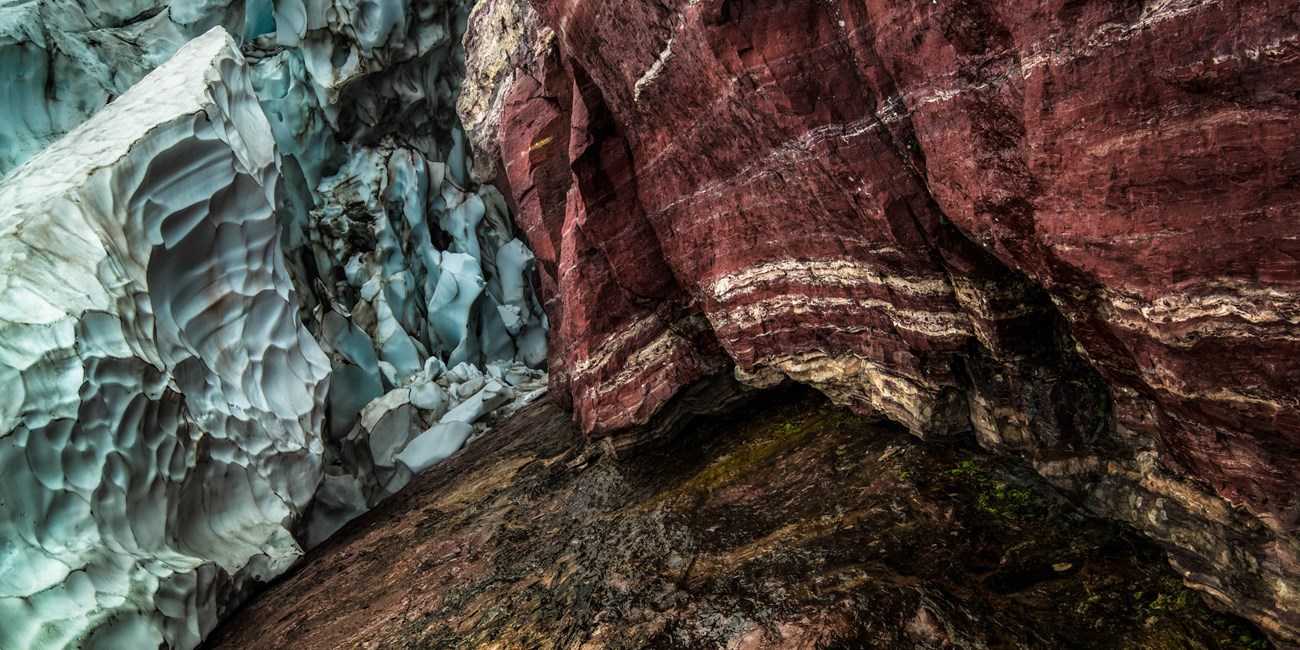
Evidence of glaciers is all around the park.Glaciers are masses of ice that are so big they move under the influence of gravity. They grow when winter snow accumulation exceeds summer melting. They retreat when melting outpaces snowfall. Spotting an active glacier can be a challenge but the park's glacially carved landscapes are hard to miss. Once you know what to look for, viewing Glacier's landscape is like reading a textbook on the geologic effects of glaciation. A glacier is a mass of ice so large that it flows under its own weight. A commonly used threshold for determining if a body of ice is big enough to flow is an area of 0.1 km², which is about 25 acres. Below this size, the ice is less likely to move and is not considered a glacier. This general definition works most of the time, but there are exceptions. Some glaciers may be smaller than 0.1 km² and yet remain active. Others may stop moving under their own weight and remain larger than 0.1 km².
Imagine a year where winter snowpack doesn’t completely melt in the summer, leaving a large snowfield in a shaded, high-elevation area. It is covered by snow in the fall, and another winter’s snowpack accumulates. If this occurs year after year, more and more layers of snow accumulate. Over time, this snow slowly metamorphoses to become clear glacial ice. If the patch of snow and ice is big enough, it may begin to flow downhill, becoming a glacier.
Under the huge weight of accumulated snow and ice, the ice of a glacier begins to deform internally and flow downhill, at times sliding along its base as well. The appearance of crevasses and cracks indicate a glacier’s movement. Glaciers don't "bulldoze" landscapes as much as they melt and re-freeze them, plucking material from high-elevation areas and moving it downhill, like a conveyor belt.
The current glaciers in the park are estimated to be about 7,000 years old and peaked in size in the mid-1800s, during the Little Ice Age. Millions of years before that, during the Pleistocene Epoch (a major glacial period which is also called the Ice Age), ice covered much of the Northern Hemisphere. So much water was encased in this ice that it lowered sea levels by 300 feet! In some areas near the park, ice was a mile deep. The Pleistocene Epoch ended around 12,000 years ago.
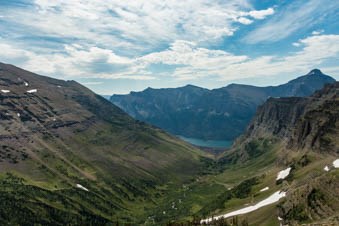
NPS photo. U-shaped ValleysLike any other form of water, glaciers follow the most direct course downhill. This means they often flow in areas previously filled by a river or stream. When a river erodes a valley into the mountains, it cuts a V-shape profile. In contrast, a glacier scours valleys into a U-shape, broad at the base and sheer on the sides. The result (when the glacier is gone) is awesome verticality and/or long, deep lakes like Lake McDonald and St. Mary Lake.
NPS photo. Hanging ValleysThe smaller the glacier, the less power it has to erode the landscape. When a small, side-channel glacier feeds into a larger and deeper-cutting glacier (like a small stream flowing into a larger river), the smaller glacier often leaves behind a much higher-elevation valley that dramatically ends in mid-air. This is called hanging valley. The hanging valley above Bird Woman Falls is a textbook example, but they can be seen in many other places throughout the park.
NPS photo. Arêtes and HornsSaw-toothed arêtes, like the Garden Wall, mark places where two glaciers carved each side of a ridge. Craggy horns are mountain peaks that were scraped nearly vertical by glaciers on three or more sides. Examples in Glacier include Flinsch Peak, Reynolds Mountain, and the Little Matterhorn.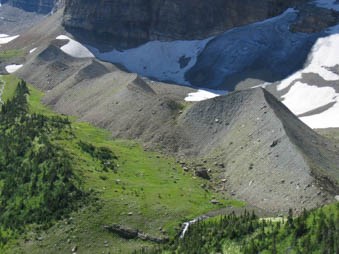
USGS photo by Lisa McKeon. MorainesThe conveyor belt motion of a glacier carries debris downhill—from massive rocks to the smallest pebbles and grains of sand—which it then deposits at the far edge of the glacier where the ice is melting. When a glacier’s end (called its terminus) remains in the same place for a period of time, it dumps this material in a single spot where it accumulates in a sharp-edged ridge of loose rock, sand, and silt. This ridge is called a moraine. The longer a glacier stays in one spot—which requires a steady climate—the larger this moraine will be.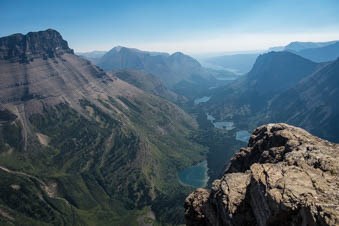
NPS photo. Paternoster LakesAs a massive valley glacier retreats at the end of an ice age, it doesn’t necessarily melt in a steady trajectory. During cooler climatic periods, its retreat may pause, with the glacier remaining in a steady state for decades, or even longer. Wherever the glacier’s tip remains in one place for an extended period of time, a small moraine will start to form. If this happens repeatedly, a series of these moraines will form as the ice retreats up the valley. They each fill with meltwater, creating a chain of small lakes in the glacial valley. This string of successive lakes is known as paternoster lakes, because of their resemblance to rosary beads.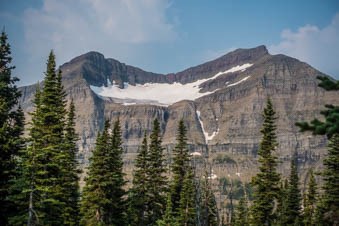
NPS photo. Cirques and TarnsIf you picture an ice cream scoop carving out a chunk of mountain, what’s left behind is a rounded amphitheater. Called a cirque, these round, steep-sided valleys are carved by the head of a glacier. Many park cirques still hold glaciers, long-standing snowfields, or lakes. These small alpine lakes are often called tarns.
|
Last updated: September 19, 2024




